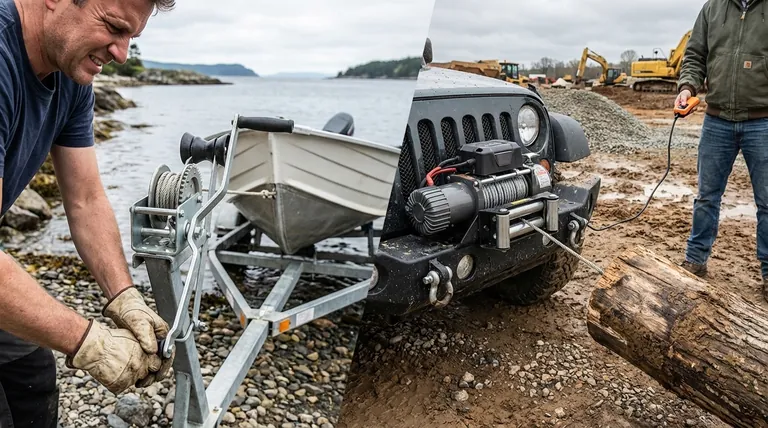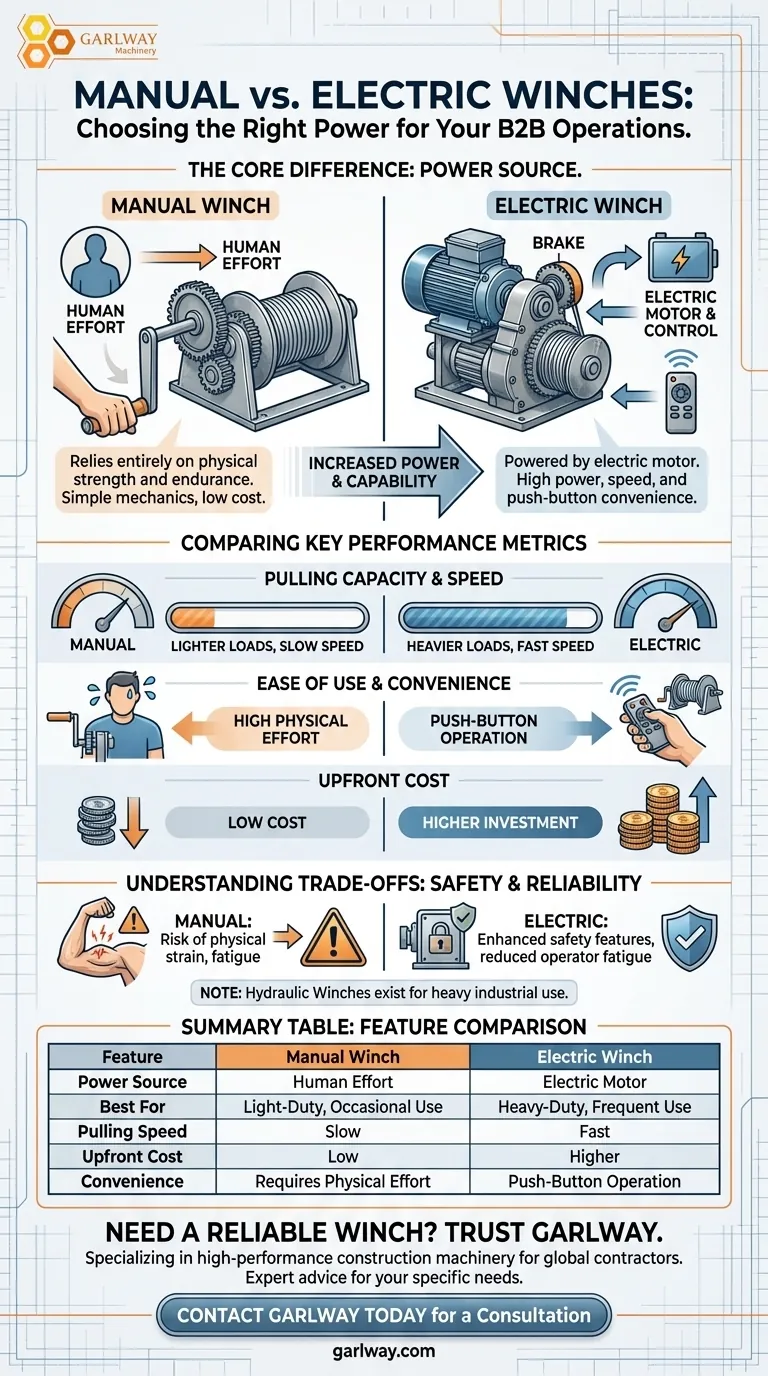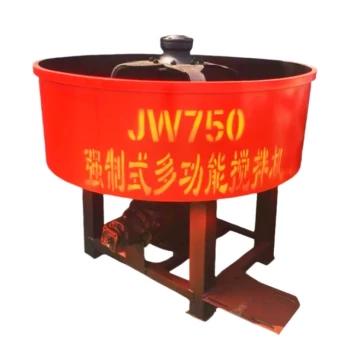The core difference between a manual and an electric winch is the power source. A manual winch relies entirely on your physical effort to turn a crank or lever, while an electric winch uses an electric motor to do the heavy lifting. This fundamental distinction dictates their power, speed, cost, and suitability for different tasks.
The choice between manual and electric is a direct trade-off between cost and capability. Manual winches offer a low-cost solution for infrequent, light-duty tasks, whereas electric winches provide the power, speed, and convenience necessary for heavier or more frequent operations.

The Fundamental Difference: Power Source and Operation
Manual Winches: Human-Powered Simplicity
A manual winch is a purely mechanical device. Its operation depends on you physically turning a crank to wind the cable onto the drum, using gear reduction to multiply your force.
This design is simple, with fewer parts that can fail. However, it means the pulling power and speed are limited by your own strength and endurance.
Electric Winches: Motorized Power and Control
Electric winches integrate an electric motor, gearbox, brake, and drum into a single unit. These are powered by a vehicle's electrical system or another external power source.
Key components like a solenoid act as an electrical switch, and a control system—often a wired or wireless remote—allows you to operate the winch from a safe distance. This provides significant power and convenience without physical strain.
Comparing Key Performance Metrics
Pulling Capacity and Speed
Manual winches are best suited for lighter loads. Their speed is inherently slow, making larger jobs time-consuming and laborious.
Electric winches offer substantially more pulling power and are significantly faster. They are the standard for tasks requiring high loading capacity, such as vehicle recovery or loading heavy equipment onto a trailer.
Ease of Use and Convenience
Operating a manual winch requires significant physical effort, which can be difficult and tiring, especially under load.
An electric winch does all the hard work for you at the push of a button. The inclusion of remote controls adds a layer of convenience and safety, allowing for better visibility and positioning during a pull.
Understanding the Trade-offs
The Upfront Cost
The most significant advantage of a manual winch is its low cost. They are substantially cheaper than their electric counterparts, making them an accessible option for those on a tight budget.
Electric winches represent a larger financial investment due to their complex components, including the motor, electronics, and control systems.
Safety and Reliability
While mechanically simple, manual winches introduce the risk of physical strain or injury from repetitive effort.
Electric winches often have enhanced safety features, such as automatic brakes and enclosed systems. By removing the need for manual cranking, they reduce the potential for operator fatigue and error during critical tasks.
A Note on Other Winch Types
For complete context, it's worth knowing a third category exists: hydraulic winches. These are typically reserved for heavy industrial or commercial applications and are powered by a hydraulic system, but electric winches remain the most common type for consumer and prosumer use.
Making the Right Choice for Your Application
The right winch is the one that safely and effectively matches your intended job.
- If your primary focus is occasional, light-duty tasks on a tight budget: A manual winch provides a simple, cost-effective solution.
- If your primary focus is frequent use, heavy loads, or safety and convenience: An electric winch is the superior investment for its power, speed, and ease of use.
- If your primary focus is vehicle recovery or regularly loading a trailer: An electric winch is almost always the correct and safer choice due to the high loads involved.
Understanding these core trade-offs empowers you to select the right tool for the job.
Summary Table:
| Feature | Manual Winch | Electric Winch |
|---|---|---|
| Power Source | Human Effort | Electric Motor |
| Best For | Light-Duty, Occasional Use | Heavy-Duty, Frequent Use |
| Pulling Speed | Slow | Fast |
| Upfront Cost | Low | Higher |
| Convenience | Requires Physical Effort | Push-Button Operation |
Need a reliable winch for your construction project? Choosing the right equipment is critical for safety and efficiency. GARLWAY specializes in high-performance construction machinery, offering durable electric and manual winches for contractors and construction companies globally. Let our experts help you select the perfect winch for your specific needs.
Contact GARLWAY today for a consultation and discover how our winches can enhance your operational power and safety!
Visual Guide

Related Products
- Ready Mixer Machine for Construction Ready Mix Machinery
- Electric and Hydraulic Winch for Heavy Duty Applications
- Portable Concrete Mixer Machine Equipment for Mixing Concrete
- Warn Winch Windlass Boat Trailer Winch
- JZC400 Mobile Small Concrete Mixer Cement Mixer Machine
People Also Ask
- Which type of projects require a concrete mixer? Essential Guide for Construction Pros
- Can a concrete mixer be used for mortar? Understanding the trade-offs for your project
- Why is cleaning a concrete mixer after use important? Avoid Costly Repairs and Ensure Quality
- What safety considerations are important for concrete mixer operation? A Guide to Proactive Risk Management
- When was the first concrete mixer developed and by whom? Discover the 1900 Breakthrough



















